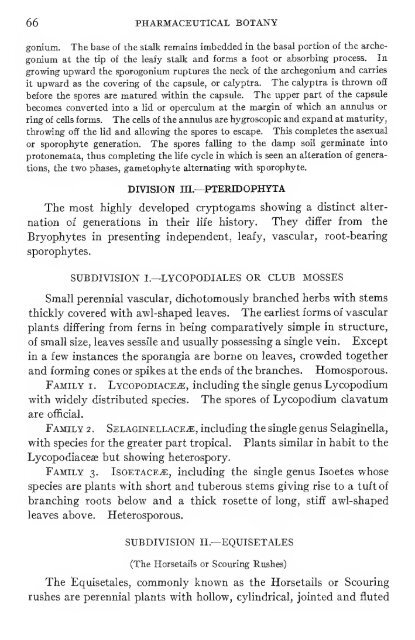Pharmaceutical botany - Lighthouse Survival Blog
Pharmaceutical botany - Lighthouse Survival Blog
Pharmaceutical botany - Lighthouse Survival Blog
You also want an ePaper? Increase the reach of your titles
YUMPU automatically turns print PDFs into web optimized ePapers that Google loves.
66 PHARMACEUTICAL BOTANY<br />
gonium. The base of the stalk remains imbedded in the basal portion of the archegonium<br />
at the tip of the leafy stalk and forms a foot or absorbing process. In<br />
growing upward the sporogonium ruptures the neck of the archegonium and carries<br />
it upward as the covering of the capsule, or calyptra. The calyptra is thrown off<br />
before the spores are matured within the capsule. The upper part of the capsule<br />
becomes converted into a lid or operculum at the margin of which an annulus or<br />
ring of cells forms. The cells of the annulus are hygroscopic and expand at maturity,<br />
throwing off the lid and allowing the spores to escape. This completes the asexual<br />
or sporophyte generation. The spores falling to the damp soil germinate into<br />
protonemata, thus completing the life cycle in which is seen an alteration of genera-<br />
tions, the two phases, gametophyte alternating with sporophyte.<br />
DIVISION III—PTERIDOPHYTA<br />
The most highly developed cryptogams showing a distinct alter-<br />
nation of generations in their life history. They differ from the<br />
Bryophytes in presenting independent, leafy, vascular, root-bearing<br />
sporophytes.<br />
SUBDIVISION I.—LYCOPODIALES OR CLUB MOSSES<br />
Small perennial vascular, dichotomously branched herbs with stems<br />
thickly covered with awl-shaped leaves. The earliest forms of vascular<br />
plants differing from ferns in being comparatively simple in structure,<br />
of small size, leaves sessile and usually possessing a single vein. Except<br />
in a few instances the sporangia are borne on leaves, crowded together<br />
and forming cones or spikes at the ends of the branches. Homosporous.<br />
Family i. Lycopodiace^, including the single genus Lycopodium<br />
with widely distributed species. The spores of Lycopodium clavatum<br />
are ofEcial.<br />
Family 2. Selaginellace^, including the single genus Selaginella,<br />
with species for the greater part tropical. Plants similar in habit to the<br />
Lycopodiaceas but showing heterospory.<br />
Family 3. Isoetace^, including the single genus Isoetes whose<br />
species are plants with short and tuberous stems giving rise to a tuft of<br />
branching roots below and a thick rosette of long, stiff awl-shaped<br />
leaves above. Heterosporous.<br />
SUBDIVISION II.—EQUISETALES<br />
(The Horsetails or Scouring Rushes)<br />
The Fquisetales, commonly known as the Horsetails or Scouring<br />
rushes are perennial plants with hollow, cylindrical, jointed and fluted
















